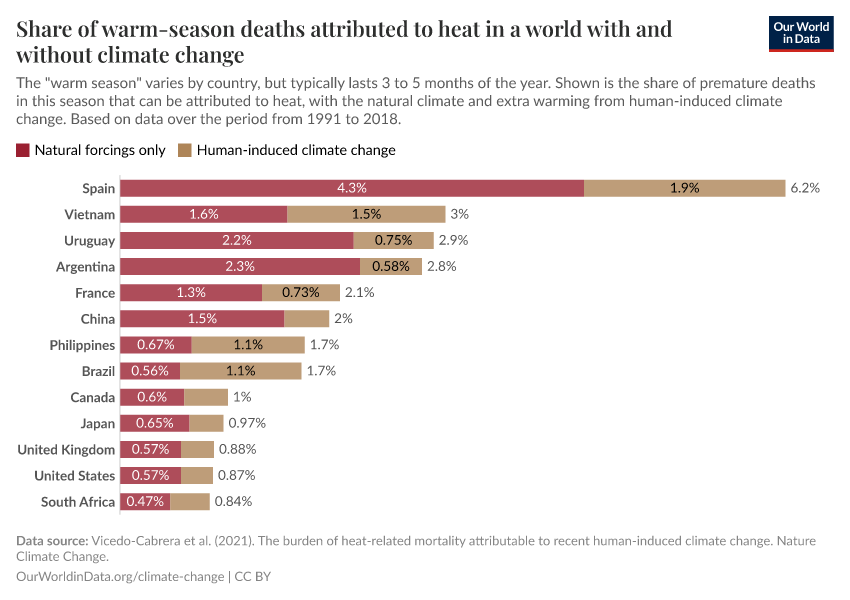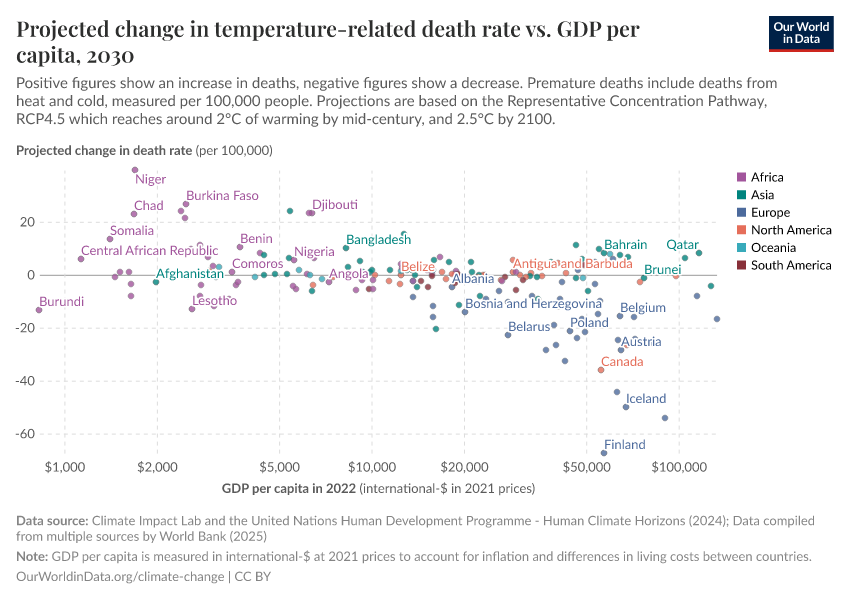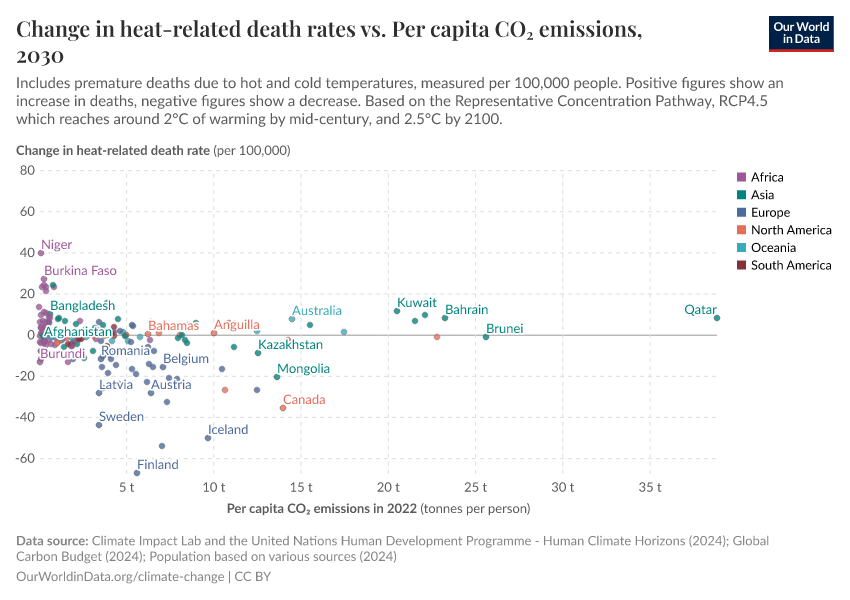How many people die from extreme temperatures, and how this could change in the future: Part two
Climate change will have very unequal impacts, with fewer deaths at higher latitudes but increased heatwave deaths across the tropics.
Every year, several million people die prematurely from temperatures that are too hot or too cold. I went through the research on this in my previous article.
As the data showed, deaths associated with cold temperatures vastly outnumber those from heat — globally, at a ratio of around nine to one.1
But as temperatures rise from climate change, we expect extreme heat to become more severe. How will this affect heat-related deaths in the future?
In this article, I examine the potential changes in temperature-related mortality — including both hot and cold deaths — and where people will be impacted most.
When I spoke to researchers on this topic, they were keen to emphasize how uncertain future impacts are. We don’t know how societies and individuals will acclimatize and adapt to extreme temperatures. A long list of factors will influence heat deaths decades from now, which are incredibly hard to model. The studies I look at below are a good starting point — and show the state of the best research today — but our understanding is still evolving, so we should always keep these uncertainties in mind.
What share of heat deaths has already been attributed to climate change?
Before we look at future changes in temperature-related mortality, it’s helpful to quantify how many heat-related deaths can already be attributed to climate change.
To answer this question, we can’t just look at the number of people that die from heat. Some people would still die from heat in a world without climate change. Instead, researchers need to quantify the difference between two scenarios: the reality of what we’ve experienced and an alternate reality without warming.
Ana Vicedo-Cabrera and colleagues studied this question across 732 locations in 43 countries in a paper published in Nature Climate Change.2
The results are shown in the chart below. The share of “warm season” deaths caused by heat is broken down by those that would have occurred with pre-climate-change temperatures and the additional share from human-induced climate change.
On average, the researchers attributed just over one-third of heat-related deaths across all countries to climate change. Note that this is not a third of all temperature-related deaths, just the ones related to warm temperatures in the warm season. This differed across countries, as the chart shows. As you can see in the chart, climate change deaths as a share of all warm season deaths was lower in more temperate climates across Europe and North America and higher – sometimes more than 50% – in Western Asia, Southeast Asia, and South America.
These researchers estimate that climate change is responsible for around 0.6% of all “warm-season” deaths across these countries; that is, 0.6% of deaths from all causes across the summer months.

Warming temperatures don’t just increase the risk of heat-related deaths. They also reduce the risk of cold-related ones. The total impact of climate change is the sum of these two opposing forces. To date, the reduction in cold-related deaths has slightly outpaced the rise of heat-related ones.
A widely-cited study by Qi Zhao and colleagues, looking at the distribution and change in temperature-related deaths from 2000 to 2019, found that heat-related deaths had increased over these decades.1 But, the number of cold-related deaths had fallen even further. In total, annual temperature-related deaths had fallen by around 650,000 per year.
This drop can’t entirely be attributed to climate change, as socioeconomic, health, and other factors have also changed. It’s also important not to overstate the certainty in these estimates. Still, as the authors conclude, it’s possible that climate change reduced global temperature-related deaths in recent decades — but with large inequalities, as we’ll see later.
How will temperature-related deaths change in the future?
This will depend on two things. First, what climate change will the world experience — do we end up at 2°C, 2.5°C, or even 3°C? The higher the temperature, the higher the risk of heat mortality. Second, can societies adapt to higher temperatures? There are things that we can do to reduce heat stress if people have the finances to afford it.
The Human Climate Horizons (HCH) — a collaboration between the Climate Impact Lab and the UN Development Programme — has done detailed mapping of future climate scenarios across the world. One of its metrics is the change in heat mortality, which is estimated based on the methodology laid out in Carleton et al. (2021).3
The team makes projections for two future climate scenarios: the Representative Concentration Pathway (RCP) 4.5 and 8.5, which are widely used in the climate literature and by the Intergovernmental Panel on Climate Change (IPCC). Here, I’m going to focus on the results from RCP4.5 because it’s much more closely aligned with our current emissions trajectory (we might even be on track to come in slightly below it).4
If we followed RCP4.5, we would expect to reach a warming of around 2°C by mid-century and around 2.5°C by 2100.
The researchers estimated how death rates from heat — which includes cold and hot temperatures – would change by 2030, 2050, and 2090.5 The change in 2050 is shown in the map below, but you can also use the time-slider to see the data for 2030 or 2090. Positive values mean higher death rates. Negative values mean a reduction.
You can see very large differences across the world. Extreme heat would increase deaths across large parts of the tropics – particularly in the Middle East and South Asia. However, in many countries, particularly at high latitudes, death rates are expected to fall in this scenario. That’s because the decline in cold-related deaths will offset the rise from heat in the countries shown in blue.

The chart below shows how these changes in temperature-related death rates are estimated to change over time.
There are some countries where any increase in temperature is expected to increase temperature-related deaths; the death rate in places like Nigeria, Bangladesh, and Qatar will be higher in 2030 and continue to go up with every 0.5°C of warming. The opposite is true for other countries. The chart shows in the United Kingdom, Sweden, and Canada, warming is expected to reduce temperature-related deaths.
But this isn’t the case everywhere, as shown in the chart below. Researchers estimate that in Spain, for example, there is a small decline in heat-related deaths to just below 2°C (around mid-century), after which the researchers expect a net increase. In South Africa and Brazil, there is a net decline up to 2050, but deaths are on the rise by the end of the century.

It’s difficult to put these death rates into perspective. Is 10 deaths per 100,000 people a lot? To provide some context, I’ve given these same figures alongside the UN’s projected death rates for each country in its medium scenario for the future. Note that these are very crude comparisons, but give some context for how significant these changes in heat deaths could be.
For example, the UN demographers expect that in 2050, based on Qatar’s demographics, around 292 people will die for every 100,000 people in the population. I’ve shown the Human Climate Horizon estimates for the change in heat-related deaths next to it: 32 deaths per 100,000. That means that heat-related deaths could increase projected deaths in Qatar by over 10%.
In Bangladesh, it’s an increase of 20, compared to 743: around 2.7% more.
The increase (or decrease for countries like the US or UK) is much smaller in other countries.

That doesn’t necessarily mean the change in deaths is small in absolute numbers. Take the example of India. These projections suggest that by 2050, heat-related death rates could increase by 6 per 100,000 people. Using India’s population projections, I estimate that this equates to an additional 100,000 yearly deaths.6 Not a small number. But by 2050, around 14.6 million people are expected to die each year from all causes as the population gets older. 100,000 is, therefore, a small percentage of the total.
I spent a lot of time looking at other studies estimating deaths from extreme heat in the future. While the results are rarely identical – some, for example, expect a net decline in deaths in Australia, while the study above expects an increase – the general patterns worldwide are fairly consistent.
A study by Antonio Gasparrini and colleagues looked at changes in death rates across 451 locations in 23 countries under different climate scenarios to the end of the century.7 In the RCP4.5 scenario (the one used above), it found a reduction in heat deaths across North America, Northern Europe, East Asia, and Central America but a net increase in Southern Europe, Asia, and America, particularly in the second half of the century. This was in the order of a few percentage points – similar to the increase for countries like Bangladesh that we looked at before.
A recent study published in Nature Communications found a similar pattern: net reductions in heat-related deaths in higher-latitude countries across Europe and North America but increases in deaths in Southern Europe, South America, Asia, and Africa, particularly at warming greater than 2°C.8 Crucially, they found that population aging would significantly impact the changes in heat mortality because older populations are most vulnerable. According to this study, around one-quarter of the increase in heat deaths is attributed to aging alone.
The inequality of climate change impacts
What’s consistent across the research is that changes in heat mortality reveal deep inequalities between those driving climate change and those suffering most from the consequences.
Fewer people will die in most rich countries — particularly across Europe and North America — as a result of climate change. Deaths in many poor countries will probably go up (although these figures have large uncertainties because acclimatization, adaptation, and other factors are very difficult to model).
This is the harsh inequality of climate change.
This relationship is clearly visible if we plot the projected change in death rates in 2050 against the current gross domestic product (GDP) per person. Death rates are expected to increase in many of the poorest countries (on the left) and decrease in most rich countries (on the right).

We can also see this if we plot death rates against carbon (CO2) emissions per person.
The chart's top right shows that death rates are expected to increase in most oil-producing states with a high carbon footprint per person.
Aside from this handful of countries, there is a strong negative relationship — on the left-hand side of the chart — between emissions and projected mortality. Death rates are expected to increase in countries with tiny carbon footprints — often less than a few tonnes per person — but could decrease in the countries with large carbon emissions. The burden will be put on the countries that have contributed almost nothing to the problem.

Adaptation and heat acclimatization are crucial
The research is clear: as temperatures rise, people living at lower latitudes — particularly in the tropics but also extending to Southern Europe – will be increasingly pushed into damaging and potentially fatal temperatures. These mortality risks increase mostly steeply past 2°C. To prevent these deaths, we need to keep temperatures as low as possible by reducing carbon emissions.
But that won’t solve this alone. Some climate change is already locked in. We must ensure that populations have the tools and systems they need to adapt to increased temperatures.
Humans are not helpless when confronted with environmental pressures. We’ve become more resilient to disasters like droughts, floods, and cyclones. Even if we look at heat impacts, deaths from hot temperatures have actually decreased in some regions despite warming.9 That’s because the underlying health of populations, access to health, and adaptations are improving.
Look at the methodologies researchers use to estimate heat-related deaths, which I shared in my preceding article. They make clear just how large the role of acclimatization and adaptation is: Cities and regions across the world have very different “optimal temperature” curves. Death rates rise steeply in London or Paris at relatively modest temperatures compared to New Delhi, where local populations are acclimatized, or Austin in the United States, where most of the population has air conditioning.
The problem is that the role of acclimatization and adaptation is incredibly difficult to model. Studies that assume that these mortality risk curves are fixed — and that populations won’t adapt or acclimatize — probably overestimate the impact of climate change on heat deaths. But it’s hard to estimate how large this effect might be.
Nonetheless, two things are true. First, heat mortality will be an increasing problem as the planet warms. Second, there are things that societies and individuals can do to protect themselves. That puts pressure on us to develop systems that are more resilient to heat in the future.
We won’t be able to eliminate temperature-related deaths, but there is a lot that we can do to protect people – especially those who will be pushed to the brink of human comfort and survivability.
That’s the focus of my next article.
Acknowledgements
Many thanks to Max Roser and Edouard Mathieu for their comments on this article and to Pierre Masselot for invaluable feedback on this research.
This article is part of a series on extreme heat:
Endnotes
Zhao, Q., Guo, Y., Ye, T., Gasparrini, A., Tong, S., Overcenco, A., ... & Li, S. (2021). Global, regional, and national burden of mortality associated with non-optimal ambient temperatures from 2000 to 2019: a three-stage modelling study. The Lancet Planetary Health, 5(7), e415-e425.
Vicedo-Cabrera, A. M., Scovronick, N., Sera, F., Royé, D., Schneider, R., Tobias, A., ... & Gasparrini, A. (2021). The burden of heat-related mortality attributable to recent human-induced climate change. Nature Climate Change.
One key caveat to this work is that it’s based on annual data, which may underestimate the impact of extreme temperatures, which tend to occur from short-term exposure over days, or weeks at a maximum.
Higher-resolution data covering shorter timescales could improve these estimates.
Carleton, T., Amir, J., Delgado, M., et al. (2022). Valuing the Global Mortality Consequences of Climate Change Accounting for Adaptation Costs and Benefits. The Quarterly Journal of Economics.
The world is very unlikely to follow RCP8.5; for more details, see this article by Zeke Hausfather and Glen Peters. Many others, such as Justin Ritchie and Roger Pielke, have also written about the implausibility of RCP8.5.
In the study, they split these into 20-year bins, which I’ve labeled as the mid-year of the period. For example, the 2050 data is the annual average from 2040 to 2059.
India’s population is projected to be around 1.67 billion. 6 deaths per 100,000 people is around 100,000 [1.67 billion / 100,000 * 6 = 100,200].
Gasparrini, A., Guo, Y., Sera, F., Vicedo-Cabrera, A. M., Huber, V., Tong, S., ... & Armstrong, B. (2017). Projections of temperature-related excess mortality under climate change scenarios. The Lancet Planetary Health.
Chen, K., De Schrijver, E., Sivaraj, S., Sera, F., Scovronick, N., Jiang, L., ... & Vicedo-Cabrera, A. M. (2024). Impact of population aging on future temperature-related mortality at different global warming levels. Nature Communications.
Sheridan, S. C., & Allen, M. J. (2018). Temporal trends in human vulnerability to excessive heat. Environmental Research Letters.
Cite this work
Our articles and data visualizations rely on work from many different people and organizations. When citing this article, please also cite the underlying data sources. This article can be cited as:
Hannah Ritchie (2024) - “How many people die from extreme temperatures, and how this could change in the future: Part two” Published online at OurWorldinData.org. Retrieved from: 'https://archive.ourworldindata.org/20251220-152415/part-two-how-many-people-die-from-extreme-temperatures-and-how-could-this-change-in-the-future.html' [Online Resource] (archived on December 20, 2025).BibTeX citation
@article{owid-part-two-how-many-people-die-from-extreme-temperatures-and-how-could-this-change-in-the-future,
author = {Hannah Ritchie},
title = {How many people die from extreme temperatures, and how this could change in the future: Part two},
journal = {Our World in Data},
year = {2024},
note = {https://archive.ourworldindata.org/20251220-152415/part-two-how-many-people-die-from-extreme-temperatures-and-how-could-this-change-in-the-future.html}
}Reuse this work freely
All visualizations, data, and code produced by Our World in Data are completely open access under the Creative Commons BY license. You have the permission to use, distribute, and reproduce these in any medium, provided the source and authors are credited.
The data produced by third parties and made available by Our World in Data is subject to the license terms from the original third-party authors. We will always indicate the original source of the data in our documentation, so you should always check the license of any such third-party data before use and redistribution.
All of our charts can be embedded in any site.